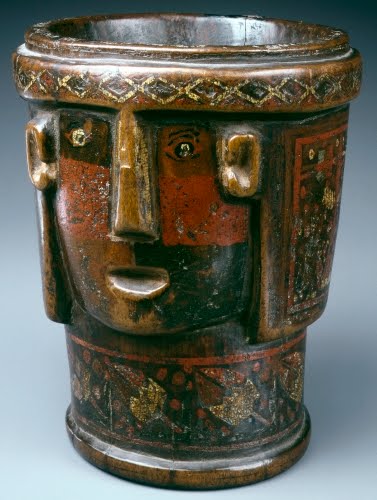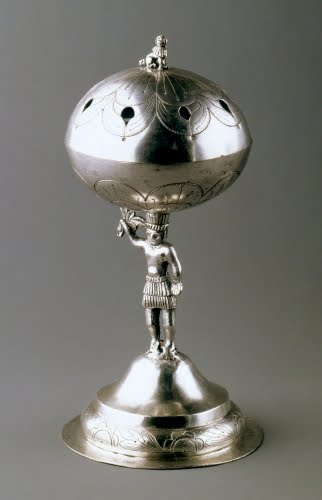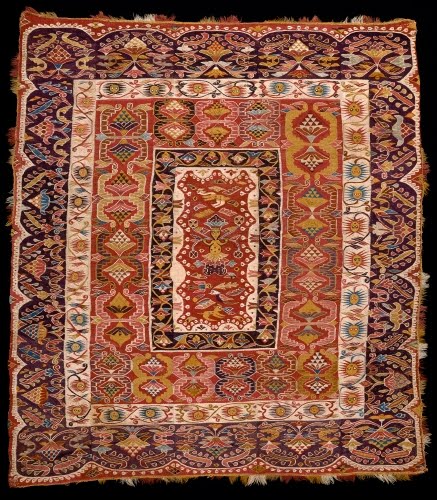The Artistic Legacy of Conquest, part 1
The Worcester Art Museum is hosting an amazing exhibition called Highest Heaven (March 11–July 9, 2017). It is a traveling exhibit of the fabulous religious art produced in Spanish colonial Central and South America, and their conquered lands in the Caribbean, from the collection of Roberta and Richard Huber. I’m not sure how “heavenly” life was for the indigenous peoples of these regions, but they certainly had a hand in producing many of the gorgeous works of art from the 1600s through the earliest 1800s.
In some cases, indigenous forms were adapted by the Spanish conquerors and Europeanized. In other cases, indigenous artists learned European techniques and adapted that to their own subject matter. This show puts me in mind of the groundbreaking one held at the Brooklyn Museum called America South of U.S. (November 1941 to January 1942). That exhibit highlighted objects from more than 1400 works the Brooklyn Museum had acquired in 1941, the earliest collection of Latin American art by a major American museum.
Today and tomorrow I will feature some examples of Spanish Colonial, not-strictly-religious, art from our image library—mostly from the Brooklyn Museum. The Huber collection from which the Worcester exhibition is drawn, has been all over the country, including the Philadelphia Museum of Art (2013), the San Antonio Art Museum (2016) and the Crocker Art Museum (2016).
 |
| Peru, Kero (beaker), from Cuzco, 1600s–1700s. Wood with inlaid pigment, 7 1/2" x 6 5/16" (19.1 x 16 cm). © 2017 Brooklyn Museum. (BMA-938) |
While only wooden kero (beaker) examples survive from the Inka culture of pre-conquest Peru, it is known that other cultures, such as the Chimú, made kero of gold and silver for the elite classes. Wooden kero with inlaid pigment decoration were common among the Inka, usually made in matching pairs for drinking corn beer. This genre of vessel continued among the indigenous Peruvians after the Spanish invasion, independent of any influence by European vessels.
The kero usually had a painted scene of the subjugation of a culture considered hostile to the Inka. This practice continued under Spanish domination. Subjugated people were often beheaded after defeat, and their skulls were sometimes made into kero. This head-form vessel is probably an allusion to that practice.
 |
| Peru, Incense burner, 1600s–1800s. Silver, 8" x 3 13/16" x 3 3/8" (20.3 x 9.8 x 8.6 cm). © 2017 Brooklyn Museum. (BMA-1265) |
Silver working was a refined art form among the indigenous Peruvians long before the Spanish conquest. New lodes were discovered and exploited by the Spanish, requiring a large indigenous work force to do the dangerous labor. In 1572, the viceroy passed a law requiring one of every seven native men to work in the mines. This levy of labor lasted throughout the colonial period and was only abolished in 1812.
Native artists easily adapted to new stylistic requirements of their Spanish conquerors. Indian artists played an important role in silversmithing throughout the colonial period. Although European silversmiths began arriving in Peru in the 1600s, native and mestizo artists were numerous in Lima and Cuzco, protected by regulations of the viceroy.
This incense burner, based on a European model, is simple in its surface decoration compared to other silver vessels of the period that were often covered in elaborate volute decoration. This burner has simple, almost neoclassical garland decoration on the lid. Noteworthy is the Indian figure that forms the support of the bowl. Artworks with depictions of the native population were very popular throughout the colonial period, and became popular tourist items during the 1800s.
 |
| Peru, Tapestry, from Cajamarca, 1700s. Camelid fiber, 77 3/4" x 67 3/4" (197.5 x 172.1 cm). © 2017 Brooklyn Museum. (BMA-4741) |
The textiles of ancient Peru, woven in every known technique for over three thousand years, represent one of the highest achievements of their cultures. Textiles were the most highly prized objects after gold in Peruvian cultures, so the indigenous cultures did not need any weaving lessons from the Spanish. The Inka were a textile-oriented culture, one in which weavings were sometimes used as money. Textiles played a significant role in the burial ceremony, in that the body of the deceased was always wrapped in some sort of weaving.
This piece, an example of sectional weaving in which the different bands were joined by single interlocking junctures, may have been influenced from bed coverings from Alpujarra in Granada, Spain. The central panel is unique because it contains a mermaid accompanied with traditional Inka stylized animals. The single-direction orientation of the central piece, and the four-way orientation of the borders, assigns this to a possible single Spanish influence.


Comments